These numbers make online dating apps and other similar tools the primary way of meeting people. With the demand as high as it is and the market as unsaturated with viral apps as it is, can there be a place for entrepreneurs and for startup owners to wedge in the dating industry, and perhaps, make it? If you are determined to take a shot in the industry, let’s talk about dating app development and figure out how to make a dating application and how much does it cost to develop a dating app?
Contents:
Today, if you own a smartphone, you’re carrying a 24/7 singles bar in your pocket.”
Aziz Ansari, comedian
How dating apps work
A reasonable follow-up to that fact from the intro is the question: what is the best way to meet online? Is it a specific website, social media, or an app? The numbers we provided belong exclusively to the mobile dating applications, with a huge chunk in the big T. With every other major aspect of our lives having conveniently found its place in our mobile phone, it would have been strange if there was no place for online dating. After all, what is a more convenient way to check on singles if not casually, while taking a break from work, commuting, or watching TV?
In one of our previous articles, we examined the question of what makes dating apps work. Basically, the selection of a suitable person involves standard categories: gender, age, geographical location, interests, and goals of acquaintance. The more parameters match, the more probable it is that you’ll be shown a profile of that particular person. Some apps offer to fill-in extensive forms with questions to better determine who matches you better. Or you can apply said filters yourself.
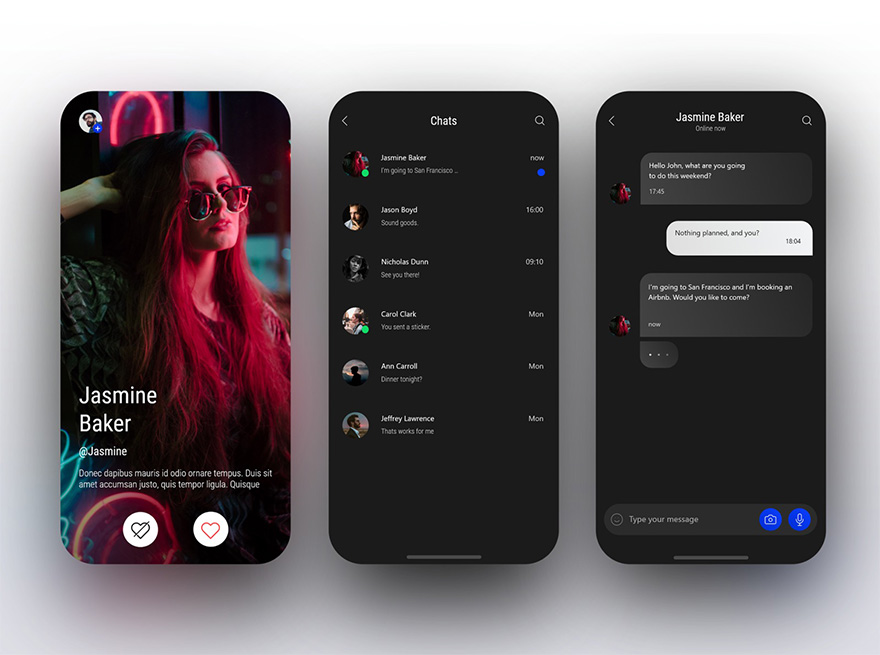
Dating App Concept by Shahram Shahbazi
What people expect from dating apps
One of the reasons why online the dating concept became so popular is the fact that you can screen people before you go out with them. Back in the day, people used to be complete mysteries and it took a personal meeting experience to decipher them. Being a special concern for women, safety is the highest priority expectation. The ability to get some insights on a person’s background through some sort of validation might be your future dating app’s forte.
Another thing to consider is the value of the application. Apart from the obvious matching, your dating mobile app development has to present a clear and valuable solution to the user problems. The reason why a dating app UX is unique and viral is the effectiveness and ease of usage. Like any of the location-based apps, dating apps present opportunities at the moment. A person you might like and who might like you can slip away from your radar forever. This creates urgency and the often-frowned-upon addiction to swiping left and right.
Some would argue that the best place to find a partner is a real-life group of people with common interests. Work, hobbies, studies — all these and more count. The problem is that not every hobby is social, and as for work and studies, well, there’s one word for it — 2020. In one of our other articles about dating app development (only this time about Tinder’s greatest rival in North America — Bumble), we tell about how dating apps actually experience upsurges during quarantines. When all your work and studies happen at home and take the majority of your waking hours, it becomes even more difficult to meet new people offline. The previous year happened to be a small renaissance for online dating worldwide and the reason for many entrepreneurs to wonder how to start a dating app business of their own.
What’s more, the indisputable benefit of any dating application is that it contains a pool of people with the same purposes as you as opposed to the reality where only part of people wants to find a partner as well.
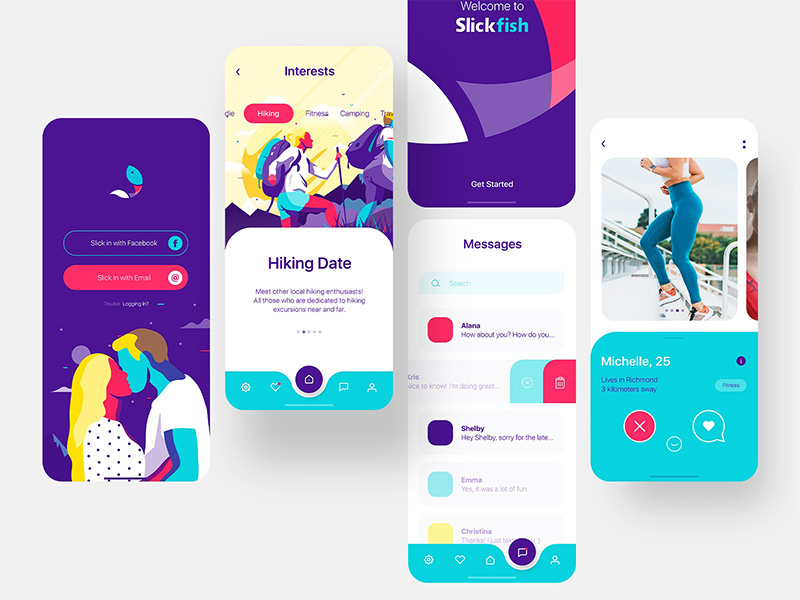
Dating App by Broklin Onjei
So, whatever the outcome, you are destined to gain personal growth and learn more about yourself. An amazing piece by John Fischer called “Tragedy, Swipe Left” is there to demonstrate the entire spectrum of experiences dating apps give. So, in a nutshell, this is what people expect from a dating app after they install it:
- Privacy and safety.
- Matches.
- Convenience.
Why users delete dating apps
This might sound obvious, but according to a research by The Manifest most people download dating apps because they are curious (29%). Convenience as a reason comes second (19%), and boredom comes third (15%):
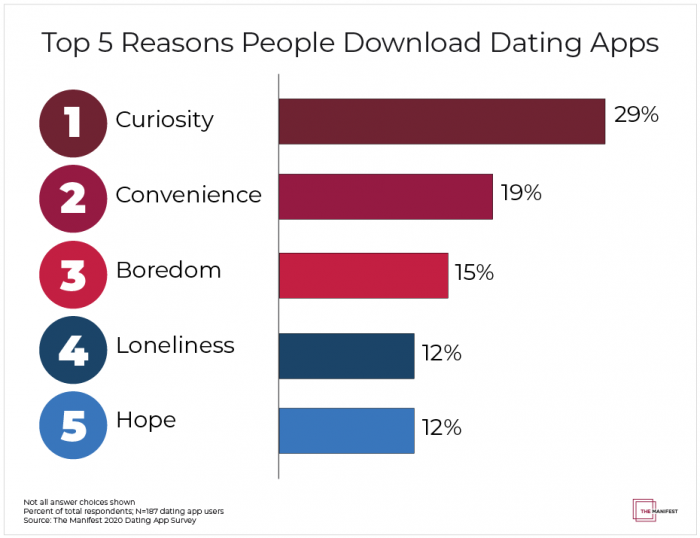
Users delete apps most often because they get bored (25%) and because apps cause stress (18%):
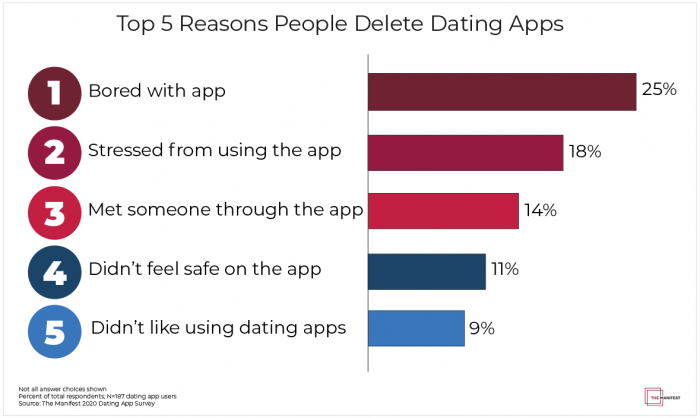
57% of survey participants admitted that they rate the experience of using a dating site or application as positive. But 42%, on the contrary, considered their experience of interaction with such services negative.
Stress that we get while using such apps is often the result of their design. This is why Tinder uses “matches” instead of the “invite-decline” method. Tinder does not provide statistical information. This means that people’s self-esteem is safe: no one will know how many times he was rejected or, on the contrary, chosen. Only mutual and voluntary communication.
Dating apps market, statistics, and trends
The online dating market was projected to grow to $3,601 million in revenue by the end of 2021.
According to ResearchAndMarkets, the Global Dating Apps Market is likely to surpass $8.4 billion by 2024 at a CAGR of approximately 6% with the annual profit steadily rising with every passing year.
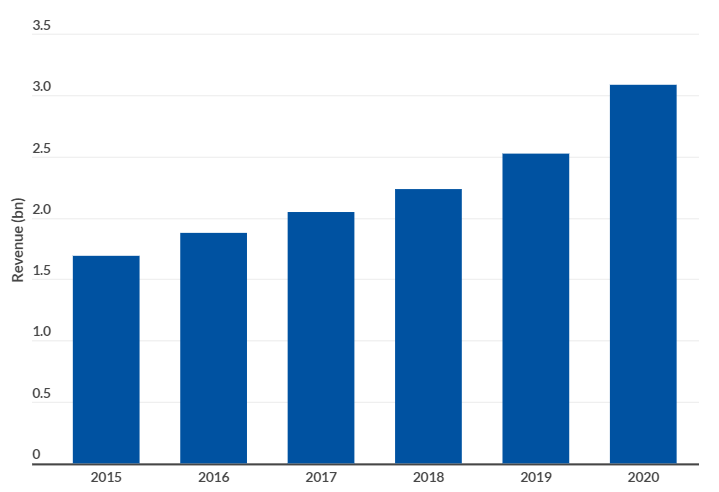
Image: businessofapps.com
The major players operating in the worldwide dating apps market are Match Group, Inc. (OkCupid, PlentyOfFish, Tinder, and Match.com), Badoo, eHarmony, Inc., Grindr LLC, FTW & Co (Happn). In the USA, the leaders are Match Group with Tinder and PlentyOfFish, and Bumble.
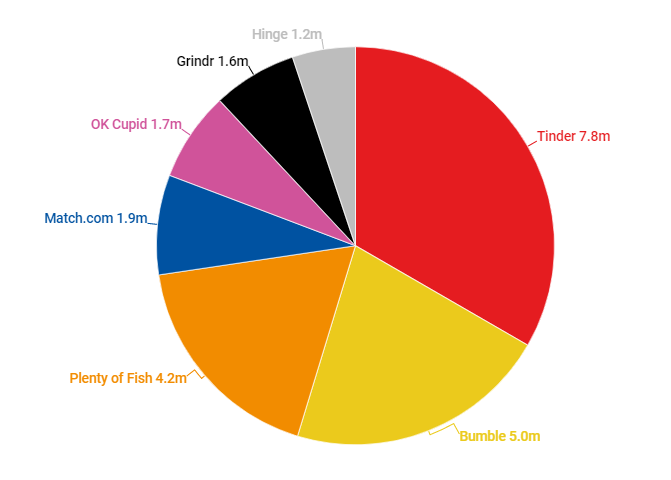
Image: businessofapps.com
Concerning trends and tendencies of the dating app market, the main ones are again connected to shifts in human communication that we all experienced in 2020, all of them connected to the adoption of new technologies. We are mainly speaking about video chats and other video-related features that all the major players have introduced (or made a central part of the products) during the last year.
Every person planning on benefiting from dating app development and thinking about how to create a dating app that would get some market share should think about how to capitalize on these and other trends. Entrepreneurs want to think more creatively in times when just swiping functionality is not enough anymore. It’s unlikely that you can beat Tinder with its clone, but you have the chance to do so with basically the same functionality but based on some particular benefit. For example, the aforementioned Bumble got so popular thanks to its strategy that gave more power to women and they didn’t stop to search for other ways to attract new loyal customers. One of their latest ideas has been to introduce a new “5 Love Languages” feature that plays on ways how different people prefer to give and receive affection.
There is more and more niche dating apps that are based on some particular interest from religion and sexual orientation to hobbies, jobs, and political values. Developers of such apps claim that their products ensure a deeper and more meaningful connection between like-minded people and are better suited for those who seek long-term relationships.
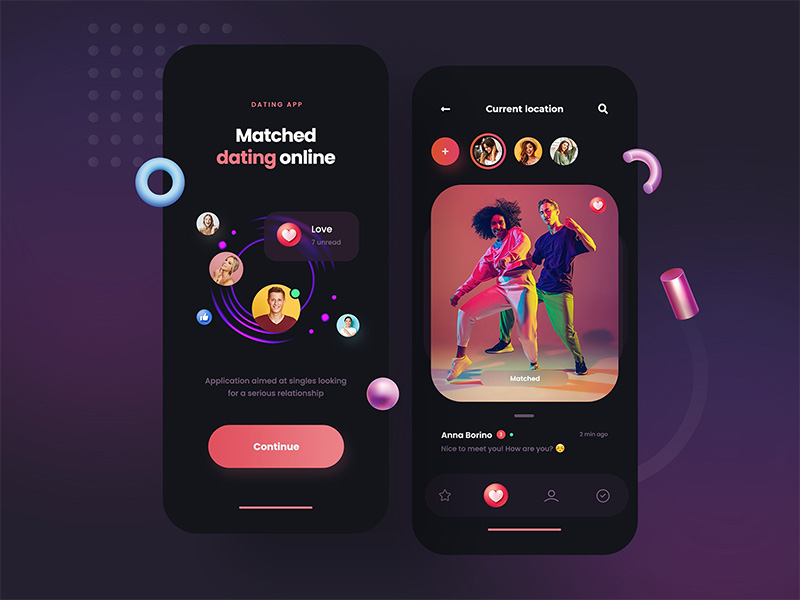
Dating app – concept by Tomasz Mazurczak
How to build an app like Tinder
Whatever the case, while Tinder is the star of the market, it’s wise to first study what made it so popular. As they say, learn the basics before you decide to jump into doing something new. True with dating app development as with anything else in this world. So what makes a dating app successful?
Tinder is a free dating app for iPhone and Android that started in 2012 and almost single-handedly built the public perception of dating apps. The previous experiences with dating websites and apps required constant involvement, which in the face of rejections, was extremely annoying. Tinder changed it all by only using physical proximity as a profile pitch factor and the swiping logic where the right swipe says “Yes” and the left one says “No” in which case you won’t be seeing that profile anymore, thus saving you some unrequited outbreaks of love. Simple and clever.
Tinder uses Facebook for authorization and profile screening, which is a smart choice due to Facebook’s ubiquitous presence and the culture of social media. Most people are good at spotting fake and impostrous accounts which makes Tinder pass the first validation in terms of security. As for being a usable solution to the problem of finding a partner, the numbers speak for the app: 65 000 000 000 matches. All this makes creating a dating app like Tinder extremely tempting.
Tinder feature analysis
Any dating app development cost depends directly on the type of features it showcases. Again, Tinder is the perfect example when you want to study the basic features of a dating app.
Tinder’s signature method relies on the geolocation service. All the UX is based on the urgency to test the waters in whatever environment life puts you. Once you and your potential match are located in one space, the app starts analyzing common interests, mutual connections, and more:
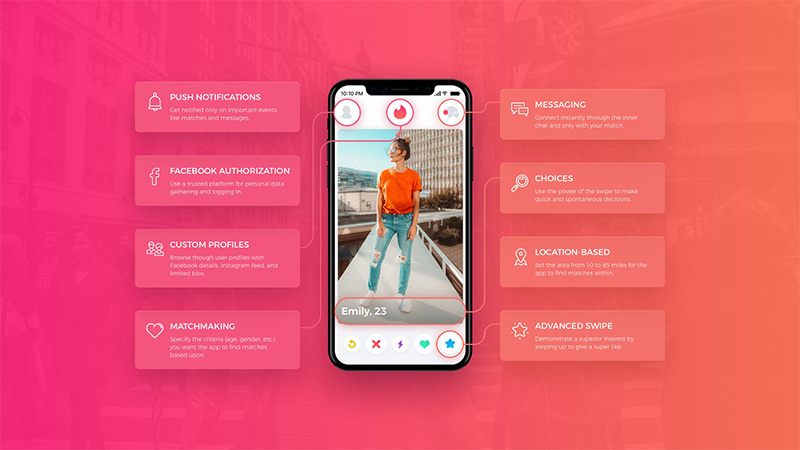
Monetization
The almost religious commitment some people have for dating apps, spending close to 2 hours a day on them, means there has to be a financial outlook on dating apps. However, an app has to be free and accessible in order to beat the competition, so the lucrative opportunity on the surface is put aside that way and use of the free-app monetization strategies like freemium.
Premium accounts
In reality, people are only willing to pay for tangible goods or experiences. Being on a dating app alone does not guarantee anything, which might potentially leave customers unsatisfied. One of the ways to get profit is offering some sort of premium features, like Tinder Plus, but again it deviates from the original purpose of the dating app. Perhaps, the most obvious option here is providing paid profile boosts to increase your chances of being swiped right.
In-app ads
So without any viable monetization schemes in an app’s performance part, one of the remaining options is advertising. Some project owners are willing to sacrifice their UX in order to make money off advertising, providing paid ad-free versions. With competition as diverse as it is in the dating app game, you wouldn’t want to break your design with annoying ads.
Promotion and affiliate marketing
A much better way to incorporate advertising in dating software development is to use relevant content. You can offer deals from businesses operating within the dating sphere of life. Coffee shops, jewelry stores, couple-related services, and special offers, etc. You can utilize tokens to buy gifts for people. Your app can distribute information and tickets to various events and thus, get exposure as well as commitment fees. Whichever opportunity to monetize your dating app occurs, it has to be considered in terms of applicability.
The general practice of successful dating app development remains the same, make your app perfect in all aspects and the acknowledgment will follow. The viral status is an ultimate money magnet. After all, you can sell the app and move on to your next project with a huge feather in the startup cap.
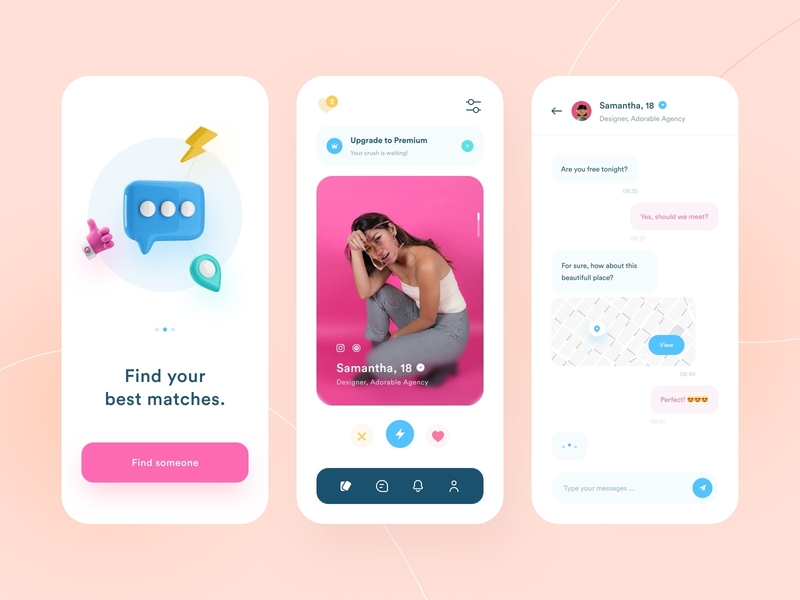
Crushonyou – Dating App Design by Farhan Fauzan
The downsides of Tinder you probably need to fix in your own app:
- There are no filters for partner search except for their gender, distance, and age, which greatly reduces the search efficiency.
- There is no user verification, that is, Tinder can’t guarantee the authenticity of the user’s photos.
- Tinder has a lot of “clones”. Apps with a “swiping” function and minimum space for your profile description are no longer a novelty. You should really think ahead so as not to get lost in the army of clones.
- Tinder has security flaws. For example, in 2017, hackers acquired 40,000 Tinder selfies and used them to make a facial dataset for AI experiments.
- Tinder values looks above everything else. There is little space for description, which is a foul play for some users.
Tinder’s technology stack
The visual simplicity of Tinder is the reflection of the massive work developers of different technologies have done. On top of the flagship app, the Tinder package includes a website and an API. Like any other complex solution incorporating massive amounts of user data, Tinder’s performance is its main asset and it has to be implemented using the best technologies available.
Now, the following information does not guarantee you a Tinder clone as building a dating app requires more than just the stack, the list of APIs, and even pieces of obfuscated source code. It is more about the perception of tasks the app helps solve and the precise knowledge of technologies capable of doing that. You can’t specifically look to hire dating apps developers as with all due respect, dating apps are not as unique as games for instance, where you can train specifically to only work in the gaming industry. Instead, the general proficiency in mobile and DB technologies can provide a cohesive app development team capable of building a successful dating app.
Android/iOS mobile app stack:
- Swift
- Objective C
- Java
- Ruby/Cucumber
- Rubymotion
Backend/API stack:
- Node.js
- JavaScript
- HTML5
- Elasticsearch
- MongoDB
- Redis
- AWS
- Python
- Bash scripting
- Mapbox
- GoDaddy SSL
Website stack:
- jQuery
- Node.js
- Nginx
Dating app UI design
The application interface is the most visual part of the experience. Part of the success Tinder had right away was in how effortless it was to perform actions related to the usually difficult ideas. Tinder turned the process of making a pass into a natural and easy thing, like swiping through photos. The real-life experience has to be the core concept of a dating app design with all its UI and UX aspects. It can’t be taking you away from each other by being too complex, instead, it has to lead you to the ultimate goal, that is to go out in person!
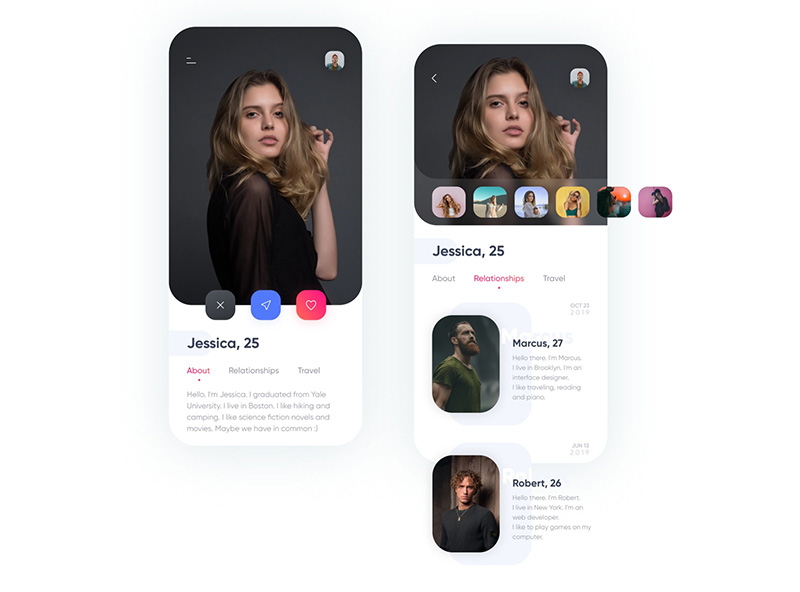
Dating App Concept by Emre Huzeyfe Baştaş
Subconsciously, this is an extremely awarding scenario, as you only get the positive outcome notifications. The design has to reflect this side of the app and turn it into a home-ish safe environment, kind of inviting people into the romantic mood.
Keeping it simple in design and functionality can help users get hooked on the purpose-driven experience of a dating app, instead of being another time killer or confidence builder. Some major companies invested in Tinder (not so) clones and failed because in their pursuit to beat Tinder, they saturated them with alien functionality and drew people into a different field. Too much customization and integrations inevitably water down the natural experience.
One more thing. To design a dating app that would have some chances to beat the competition, it’s also better not to use templates because as was said earlier, the trend now is to follow trends and find ways to offer a more authentic product, something that can’t be done with templates designs. Everything matters, from how memorable your logo is and how well a designer handles colors to whether you find the way between battling common flaws in dating app UX (read reviews on popular apps for that) and sticking to patterns that people are already used to. Sounds hard and is still harder to do.
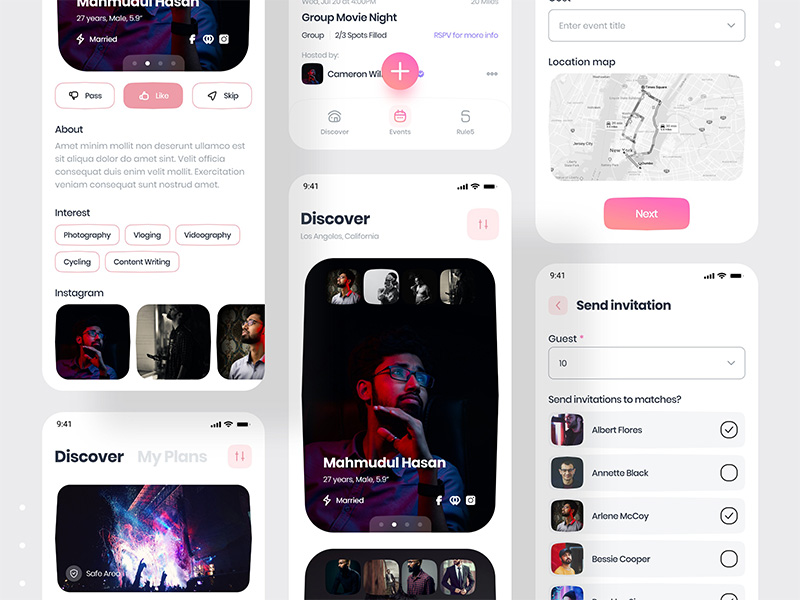
Social Communication & Dating Mobile App by Mahmudul Hasan Manik
Dating app development cost & time
With an approximate technology stack, feature breakdown, dating app design principles, and a bunch of examples that are out there, you can create a dating app that might reinvent the experience, beat Tinder, and even help yourself find your better half. Now from the fun part let’s move on to numbers and find out more about the costs of making a dating app. Any app startup is a business by itself or in the making, so things like development price and time limits need to be specified right away.
The unvarnished truth of dating app development is you’ll have to stack up a serious budget if you are committing to making a dating app like Tinder. The architecture of a native/cross-platform/hybrid app requires a complex technological solution and may build up at great lengths. Some of the components lay the base of the app’s performance and are inevitably more expensive and time-consuming. The core of a project is the mobile app.
Dating app development timescale
- The basic one-platform version might take up to 1 000 hours to develop.
- Building a backend is another 300+ hours.
- Application UI/UX design – nearly 100 hours.
- Testing and pre-launch – around 50 hours.
Dating app development direct costs
The cost of a dating mobile app development relies directly on the hourly rates of the developers you hire. You can either hire a bunch of freelancers and coordinate/sync their work, hire a local development team, or go full Jedi and dominate development outsourcing.
- Freelancers – from $10/hour.
- In-house development team – up to $150/hour.
- Outsourced development team – around $40/hour.
- Outsourced design team – around $75/hour.
Outsourcing development is a flexible approach which without a significant loss of quality and time might reduce the cost by up to 50%. Conversely, if you are looking to hire a local development team, you are likely to double the costs for the same output.
About 70% of a project development timeline is consumed by application development and backend deployment. 20% for UI/UX design and 10% for QA. In absolute figures that is:
Application development:
- iOS – $45 000.
- Android – $40 000.
Backend development:
- iOS/Android – $10 000.
UI/UX Design:
- iOS – $5 000.
- Android – $5 000.
QA engineering:
- iOS – $4 000.
- Android – $4 000.
Total cost to build a dating app:
- iOS dating app development – $64 000.
- Android dating app development – $59 000.
These approximate calculations take us to the main question after the decision to make a dating app – what are the expenses? For a Tinder-like application with basic features, similar design, and functionality patterns, you can consider:
- $55 000 as a starting point for a basic dating app;
- up to $70 000 for a single-platform app;
- from $100 000 for a cross-platform or hybrid app with premium features.
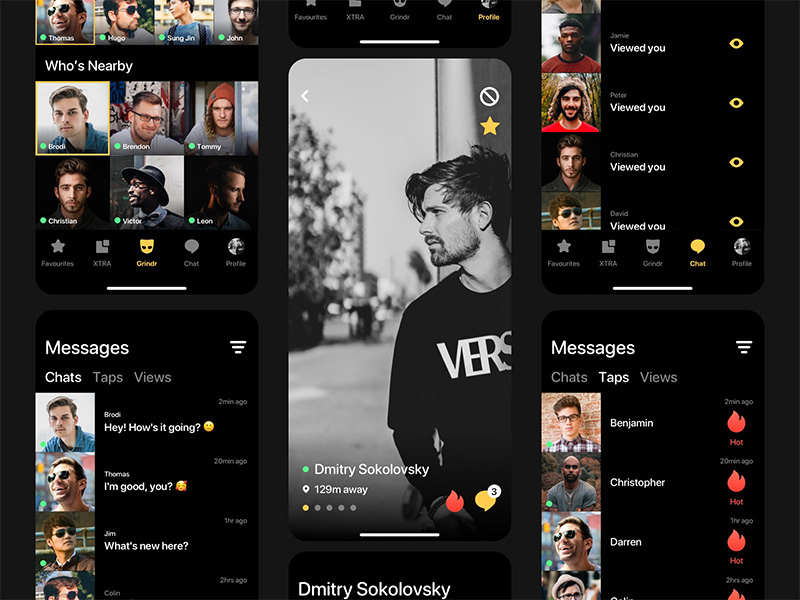
Grindr UI by David TJ Powell
If the shoe fits, wear it
With all the above, dating apps are definitely trending, now more than ever, and there seems to be no decline as we have already settled in on our mobile phones as the way to meet people. The demand that is out there requires extra work from designers and developers in terms of creating a more robust yet simple experience.
If you are determined to test the grounds as a dating app startup, we recommend hiring a competent outsourced development agency with an in-house design team, prolific back-end developers, a sharp mobile dev team, and experience in building complicated and beautiful apps at a decent cost.
We are just that. Our experience in building socializing apps is enough to be functionally ready to take on a dating app, not to mention the passion we have for this exciting journey. Looking for a dating app development company? Let’s build Tinder’s greatest rival together! Reach us.
* * *
This article about how to create a dating app was originally published in September 2017 and was updated in December 2021 to make it more relevant and comprehensive.
